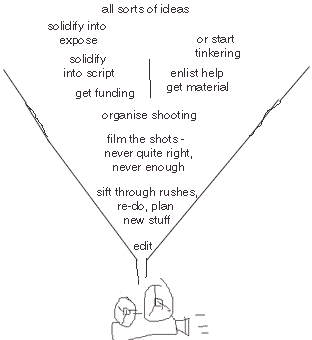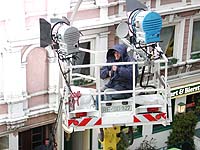
30/12/2004 (4/8/2001)
I am re-visiting this text about fim-making—it has lost its trigger, because where I live now, there are rarely film crews. I guess my resentment, my loathing of film crews and their attitude in urban space is related to my earlier failure as a film maker. After some time, I discovered that I was not suited to managing (and more importantly, being comfortable with) the film-making process, which is funnel-shaped, ending in a finite sequence to be viewed from A to Z:

—meaning that the further you move down the funnel, the less freedom of movement, the harder to change things. It's simply an expensive process and I felt the cost and potential inconvenience of those involved (also the potential anger of unpaid friends at wasteful attitudes or rejection of bad film-making outcomes) like a real burden. Usually fim-making involves several people (actors, sound & camera operators) and equipment for shooting and editing plus cars, locations, etc (of course the digital workflow has become much cheaper—witness the film "Jona" by Peter Ott (there may be DVD copies available on request, I don't know at what price)
Now to the old text.
The area where I [used to] live must be one of the most filmed in Germany. We have film crews outside at least once a week, often for several days. My immediate reaction is to curse them since they make such a fuss, blocking off the roadside for their trucks and caravans, handling pegs, unfolding their gear, laying tracks for camera movements, gesturing at people with walkie-talkie in hand. These film people with their pony tails, shades, baseball hats, smart casual jackets, kit and script and lamps and blue foil and orange foil and reflectors, assembling leisurely to space-hugging groups, smoking - they seem to feel so important. They have even learned to ignore bystanders, go about their business while soaking up the envious gazes directed at them - the lion in the jungle who cannot be prey. Knowing then that the output will be a new sequel to some dim German police series where again the script demanded that some trace had to be followed into the red-light district, where you need the seedy, the derilict, or even the faded political flavour of the Hafenstrasse houses next door, makes all this effort seem pathetic, ridiculous. Next I remember that I have been part of this business - although mostly at the cheapo independent side. So I remind me not to hate my past and therefore, to be tolerant. Then I thought why not turn to photographing these people? I remembered the division between being on the set / being outside the set - where you miss all the thrills or fun bits, where the food and the working hours are worse. For one movie I worked on preparing the sets, making up science fiction displays, joining, fiddling, cleaning, painting, spreading rubbish from the back of a pickup in a disused Motorway tunnel and in port area streets, scratching it off the wet tarmac by hand after the shooting, at dusk. I remember flimsy coffee cups with stale lukewarm coffee, social smoking, endless waiting, irritation at rumours that someone or something had fucked up which meant we had to re-do things, or stay longer before being able to go to sleep. I remember working indoors, in a deliberately soiled bar, beer-soaked carpet covered with cigarette tips, bits of broken glass, at 35 degrees Celsius. The director Emigholz needed an aperture of 8 for sufficient depth of field which meant lots of lighting that turned the narrow unventilated room turned into a stinking hell. I remember painful skin rashes, series of working days that took 17 hours, and getting ill as the effect of all this. I believe the resulting film was The holy bunch.
 So when they were again working outside our flat, turning a flat on the opposite side of the street into a setting, shooting time and again a scene where a young woman steps to the window and talks to someone else behind her (the worn-out trick: actors talking into the same direction, without eye contact, so you can see both faces in one shot). I took some photos, being unnoticed by the guy on the crane handling theoutside light. But then he discovered me, staring back (see the photograph). Its one of the thrills in photographing people, the moment when they discover you. I may assemble a series of portraits where the gaze turns back on the photographer. The photograph at the left would be part of it.
So when they were again working outside our flat, turning a flat on the opposite side of the street into a setting, shooting time and again a scene where a young woman steps to the window and talks to someone else behind her (the worn-out trick: actors talking into the same direction, without eye contact, so you can see both faces in one shot). I took some photos, being unnoticed by the guy on the crane handling theoutside light. But then he discovered me, staring back (see the photograph). Its one of the thrills in photographing people, the moment when they discover you. I may assemble a series of portraits where the gaze turns back on the photographer. The photograph at the left would be part of it.